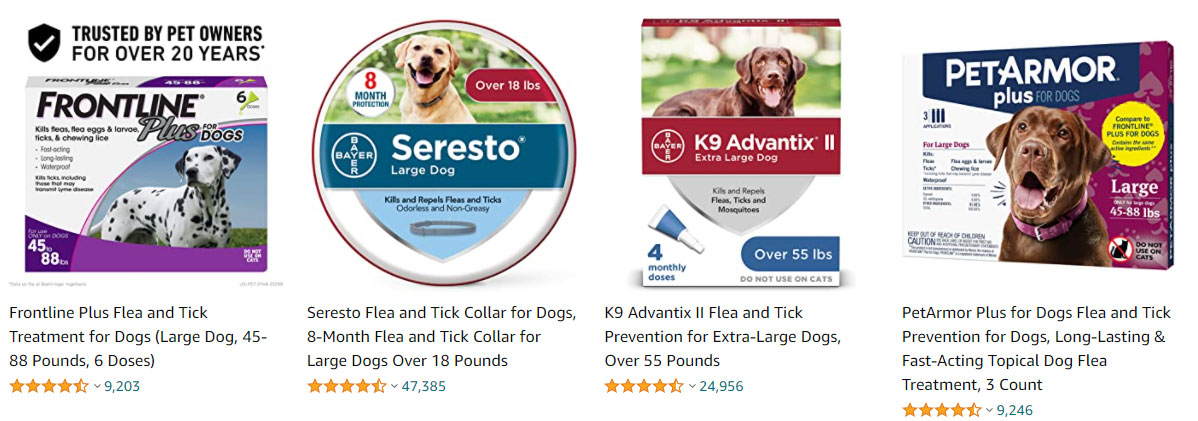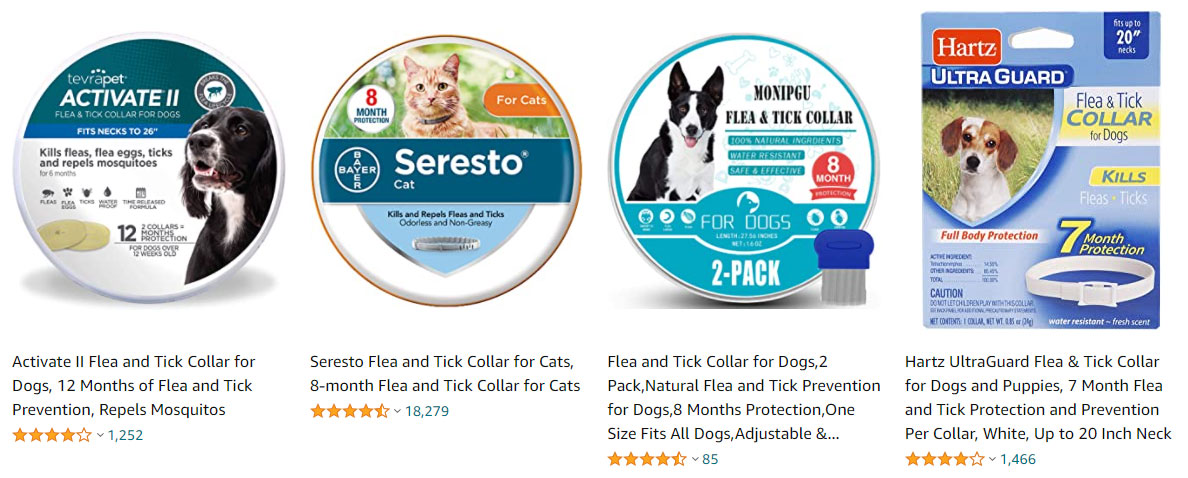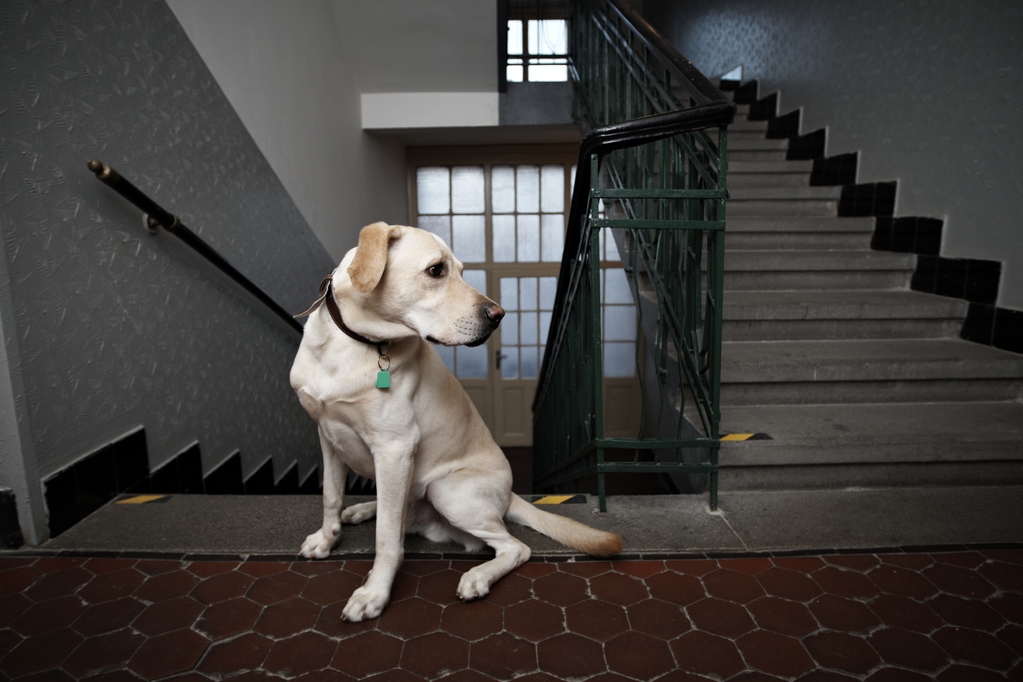Flea collar for dogs
Flea collars are certainly the most widespread anti-parasite products on the canine health market. But what about their effectiveness, and what are the different types of collars? You may already be familiar with Seresto and Scalibor, the most popular brands, but there are many other options to consider when choosing the right product for your dog. To learn more about flea collars, click here!
What is a flea collar?
For those of you who are new to the subject, here is a quick reminder about flea collars. These accessories are simply presented in the form of classic collars, but are composed of substances intended to kill or keep insects away. As a result, they have two distinct properties: insecticides and insect repellents.
Insect repellents are used to scare away pests, and insecticides to eliminate them. Insect repellents are often (but not always) composed of natural substances (essential oils, plant extracts...) and insecticides of chemical substances. Some flea collars combine these two properties.
It is also important to know that not all flea collars target the same species of insects, so choose your product according to your dog's exposure to parasites. Among the bugs eradicated by flea collars, you will of course find fleas, but also ticks, chewing lice, mosquitoes and sometimes even mites responsible for mange.
The collars gradually release active substances onto your dog's skin to kill or repel parasites. Each collar has a different composition that targets specific parasites and a different duration of use.
What do these necklaces contain?
To begin with, let's distinguish two types of collars: the "natural" and the "chemical" ones. Although some natural active ingredients have insecticidal properties, they are used more as repellents, as they are not very effective in case of flea invasions.
In the range of natural anti-flea collars, we find active ingredients such as Margosa extract, Lavandin, Geraniol or Pyrethrum. On the side of "chemical" collars, the substances commonly used are Imidacloprid, Flumethrin and Deltamethrin which attack, each in their own way, the nervous systems of insects.

How do flea collars work?
Depending on their composition and their property (insect repellent or insecticide), collars will have a different action on parasites. However, they all work in the same way: once around your dog's neck, they continuously release active substances that intoxicate or repel insects.
The Margosa, from the wood of the Margousier tree, is a natural insecticide and insect repellent that blocks the development from larva to adult. It is notably used to treat Allergic Dermatitis and to prevent flea and tick invasions.
Lavandin also has preventive virtues: it is a good repellent, also used by humans to repel lice and mites. Geraniol is a fruit alcohol, present in lemongrass, lemon and geranium. It repels flies and mosquitoes, but also fleas and ticks. And finally, pyrethrum is a flower extract (pyrethrum or chrysanthemum) with powerful insecticidal properties that destroy the nervous system of insects.
On the chemical side, Imidacloprid is an insecticide targeting fleas and lice, adults and larvae. Flumethrin is an acaride: it targets ticks and can be effective against mites responsible for scabies. This substance also prevents the production of fertile tick eggs and has a repulsive action on these parasites that can no longer feed on your dog. Finally, Deltamethrin is an acaride and insecticide, used to control ticks and mosquitoes.
How long do flea collars last?
Each brand of collar has its own characteristics, but we can say that "chemical" collars last longer than natural ones. Scalibor collars, made of Deltamethrin, effectively protect your dog from mosquitoes for 5 to 6 months (depending on the species) and from ticks for 6 months. The widely used Seresto is effective for up to 7 months against ticks and 8 months against fleas.
Collars with natural active ingredients generally have a more limited life span. The Clément Thékan brand offers insect repellent collars with Margosa extract that repel fleas and ticks for 4 months. Naturly's commercializes repulsive collars based on Geraniol effective 3 months against fleas, ticks and mosquitoes.
How do I put a flea collar on my dog?
This may seem like a silly question, but there are a few things to keep in mind when putting a flea collar on your dog. The collar should fit snugly, but not too tightly: keep a space of two fingers between your dog's neck and the collar. Since this accessory works by diffusing active substances on your pet's body, it must be in contact with his skin and not just placed on his coat. Check the fit of the collar regularly, especially on young, growing dogs.
Once the collar has been adjusted, cut off the protruding end to ensure that it will not catch on any branches or be chewed by the animal. Some dog owners place this excess piece under the cushions of their pet's basket. In this way, the habitat also benefits somewhat from the anti-flea properties of the product.
Collars have different concentrations of active ingredients depending on the weight of the animal for which they are intended. Take care to choose the right product for your dog's weight: an overdose can be harmful to its health. For a first use, ideally go to your veterinarian to weigh Medor correctly and choose the collar adapted to his needs.
Finally, note that the collar must generally be worn continuously during its entire period of use. Removing it, even occasionally (to bathe your dog, for example), may reduce its effectiveness.

FAQ
What are the precautions to take when using a flea collar?
The first thing to do, for the owner, is to wash his hands well after having handled a flea collar, and this, from the day of its installation until the end of its use 6 to 8 months later. Now, let's take a look at the precautions to take with your dog.
For which dogs is the flea collar recommended?
This anti-parasitic product can be used on all adult animals (from 7 weeks old for the most part), not convalescent and corresponding to the minimum weight indicated on the packaging. If your pet has sensitive skin and is not too exposed to parasites, the natural collar is a good option.
On which dog should it not be used?
For best results, flea collars are not recommended for dogs that are regularly in contact with water. Even if some collars are said to be water resistant, they are not completely waterproof. This simply means that occasional swimming will not affect the performance of the product.
What are the medical contraindications for flea collars?
There are few medical contraindications for flea collars. Some of them, such as Scalibor and Seresto, are not recommended for dogs with skin lesions. As a general rule, this type of product should not be used on animals with allergies to certain excipients or with hypersensitive skin.
On the other hand, collars can cause some undesirable effects. Local reactions may occur when the collar is applied: ulcers, irritation, itching, burning and peeling. In this case, remove the collar and choose another antiparasitic solution. Some active ingredients such as Dimpylate are particularly poorly tolerated, and many collars containing this ingredient have been withdrawn from the market. Deltamethrin should also be applied with caution to animals with fragile skin. More rarely, Scalibor and Seresto report lethargy or hyperactivity, gastrointestinal symptoms, hyper salivation or neurological disorders. If these effects persist 48 hours after removing the collar, consult your veterinarian.
How effective are flea collars?
Flea collars have had mixed success, often due to the clumsy use of these products. It is important to know that collars with natural ingredients are not designed to protect a dog that is highly exposed to parasites. Insecticide collars are more effective, but may not be sufficient in the case of a major flea infestation on the animal and in its environment.
In the case of large flea infestations, it is strongly recommended to treat your dog with a spray or a pipette, before applying a collar to prevent any recurrence. You should also consider treating your home with a fumigant to get rid of all the fleas, eggs and larvae that have invaded your home. For the collar to be effective, choose the right one for your dog's weight, size and lifestyle. Make sure that the collar works properly with the way you use it and that it targets the parasites that attack your dog. Finally, respect its duration of use, and avoid getting it wet too often, even if it is water resistant!
Are there natural anti-flea collars?
Yes, some brands, like Vetoform and Clément Thékan, propose natural collars containing extract of Margosa or Geraniol. These solutions can be interesting if your pet is not too exposed to parasites.
Do I have to buy my anti flea collar at the veterinary?
You don't have to buy your flea collar at the vet's, but it can be a good choice for a first use. The vet will advise you according to your dog's needs. He will also be able to give you the exact weight of your dog and tell you which collar to use.
Can I find flea collars in pharmacies?
Yes, pharmacies sell many flea collars, sometimes at better prices than at the vet's. Moreover, your pharmacist will be able to inform you about drug interactions and contraindications. The most common brands in pharmacies are Clément Thékan and Seresto.
Can I put a flea collar on my pregnant or nursing dog?
The use of chemical flea collars is not recommended for pregnant or nursing dogs. For collars based on natural active ingredients, it is on a case by case basis: read carefully the instructions or ask your veterinarian.
According to the different users' opinions, the anti-flea collar has a big advantage compared to the other anti-parasite solutions: its duration of action. The price of a collar being very reasonable, its monthly cost is really interesting. On this side, no hesitation: the flea collar is THE cheap and efficient solution to protect Medor.
However, the necklace has the disadvantage of being particularly toxic in case of contact. If you have children who tend to cuddle your doggie, the collar is not recommended! In terms of safety, but this time for your dog, it should be noted that the collar can be retained in the branches and is not always provided with a system allowing the animal to free itself.
Last black point, the collar is not necessarily effective against large flea invasions. Prefer its preventive use, after having definitively eradicated fleas with an antiparasitic tablet and a fumigant!


